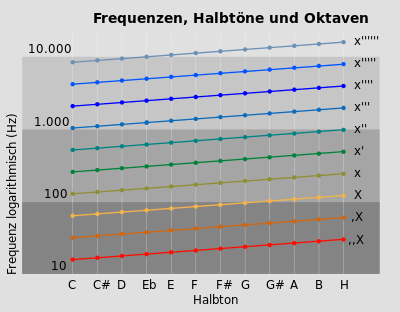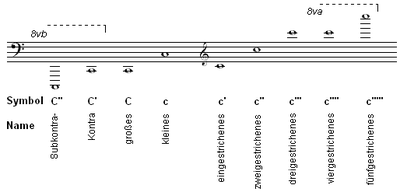octave
The octave (seldom octave , from the Latin octava 'the eighth') is the term used in music to describe the interval between two tones, which spans eight degrees of a diatonic scale .
Example : scale from f 'to f' '- octave f' f '' one after the other - octave f 'f' 'simultaneously.
![X: 2019/10 M: 4/4 L: 1/4 K: F FG | AB cd | ef z2 | F f z2 | [F2f2] |]](https://upload.wikimedia.org/score/g/l/gllta5eris3n4c9t7hvjsnkqjs95txu/gllta5er.png)
“Octave” can also mean the eighth pitch itself or an octave space (see below).
The frequency ratio of the octave interval is 2: 1, that is, the upper tone has twice the number of vibrations as the lower.

(the frequencies of the octaves are exponential to the number of octaves)
Two notes one octave apart appear very similar, almost like a unison ( prime ). It is also said that they have the same pitch class . The reason is to be found in the actual tone generation: tones of musical instruments are sounds that are composed, among other things, of the fundamental tone and several overtones . The first overtone of the fundamental has (usually) the same frequency as the fundamental that is octaved upwards . It is therefore already included in the sound of the lower note. This makes the octave the most consonant interval after the prime and is easily picked up by most listeners.
Unlike the other intervals, the octave always retains the frequency ratio of 2: 1 in all tempered tunings (an exception, however, is the stretching in piano tuning ).
In almost all musical cultures in the world, the octave is a basic interval that usually forms the basic framework for scales . Usually these scales extend over an octave space and then repeat in octave intervals (for example in the occidental tonal system ).
Reed instruments with a conically drilled tube (e.g. oboe , shawm , saxophone ) overblow into the octave for the first time, as do open flutes (e.g. transverse flute , recorder ).
Octave is also used in physics , acoustics and high frequency technology to mean “frequency ratio 2: 1” .
According to recent results in brain research, mammals have octave mapping in the auditory thalamus .
Subdivision of the pitch space into octave spaces
The Western tone system is usually divided into octave spaces (octave strips), each of which extends from the note c to the next higher note h . Each octave space has its own name for clear naming. The tones of the lower octaves are marked with upper case letters, those of the higher octaves with lower case letters (see illustration); a dash is also added for each higher or lower octave. Instead of dashes, the tone letters can be numbered (c ' = c 1 ) or, in the lower octaves, doubled ( ' C = C 1 = CC ). In the spoken form, the note name is preceded by the octave designation (e.g. "capital d" for D , " stroke g" for g ' ). The individual octave spaces, including the usual frequency spaces, are as follows:
- Subsubcontra-octave: from ‚‚ ‚C (8.2 Hz ) to‚ ‚‚ H (The tones ‚‚ ‚C to‚ ‚‚ A are no longer perceived by the human ear, while few people still hear the ‚‚ ‚H (15.5 Hz) and very few who can hear the ‚‚ ‚B (14.6 Hz))
- Subcontra octave: from ‚‚ C (16.4 Hz) to ‚‚ H (tones below 16 Hz are generally no longer perceived by the human ear)
- Contra-octave: from 'C (32.7 Hz) to' H
- Major octave: from C (65.4 Hz) to H.
- Small octave: from c (130.8 Hz) to b
- Dashed octave: from c '(261.6 Hz) to b' (the dashed a (a '= 440 Hz) is the normalized concert pitch )
- Two-stroke octave: from c '' (523.2 Hz) to h ''
- Three-stroke octave: from c '' '(1047 Hz) to h' ''
- Four-stroke octave: from c '' '' (2093 Hz) to b '' ''
- Five-stroke octave: from c '' '' '(4186 Hz) to b' '' ''
- etc. ... theoretically there is no upper limit, but in fact the hearing limit is exceeded even by infants in the eighth dashed octave at the latest
The range in which musical instruments play and can be perceived by humans usually ranges from the 'C' of the double octave (double bass, double bassoon, double bass tuba, double bass clarinet and double bass trombone) up to the C '' '' '' of the five-stroke octave (piccolo flute, glockenspiel, Celesta). Sounds outside this range are hardly used because they would be barely audible. The piano reaches down to subcontra-A (‚‚ A). Larger organs usually have a 32 'register in the pedal work that extends to the subcontra-C (' 'C).
In musical notation , in order to avoid too many guides that records sounds in a high or low position in a special way (see also. Transposing instrument ): brackets with the names 8vb (ital. Otta v a b assa : deep Octave ') and 8va (Italian otta v a a lta :' high octave ') indicate that the note should sound an octave lower or higher than notated. Occasionally there are shifts by two octaves ( 15ma or 15mb, ital. Quindicesi m a a lta / b assa ) (see octaving ). 8va or 8vb can be canceled with the designation loco .
Alternative naming systems
In addition to the system presented above, which is widely used in classical music theory, there are other pitch name systems for unambiguous naming of the pitches.
So was z. B. developed a short notation that, based on the 88-key standard keyboard , counts the octaves from bottom to top, starting with C. The contra-C ( 'C ) is the first C on the keyboard and is called C1. The five-dashed c ( c '' '' ' ) is called C8. The tone H is called B because the English-language tone names are used. The semitones are always displayed as increased with ♯ , regardless of their harmony context ( enharmonic confusion ), Gb '' would be written as F ♯ 5, for example .
This simple notation has established itself particularly in digital notation; in tracker music programs it is usually the only type of representation. Often a spectrum from C0-B9 is available beyond the standard keyboard (A0-C8), although C0 at 16.35 Hz represents the lower limit of the normal human hearing range and B9 at 15.80 kHz is at the upper limit and is no longer tonally unambiguous is determinable. Theoretically, this notation, like the classic, can be expanded in both directions as required.
variants
The octave can appear in three variants:
- (a) the pure octave is consonant and comprises 12 semitones.
as alterations are added
- (b) the diminished octave with 11 semitones and
- (c) the excessive octave with 13 semitones
which are counted among the dissonances and whose naming as octaves follows functional harmonic considerations . If altered octaves occur between successive tones of different voices, one speaks of a transverse position .



